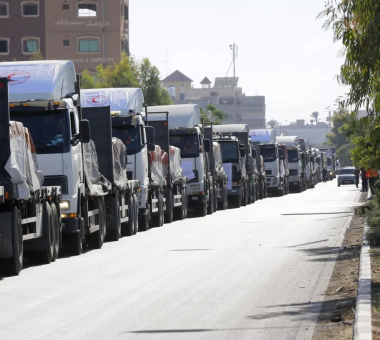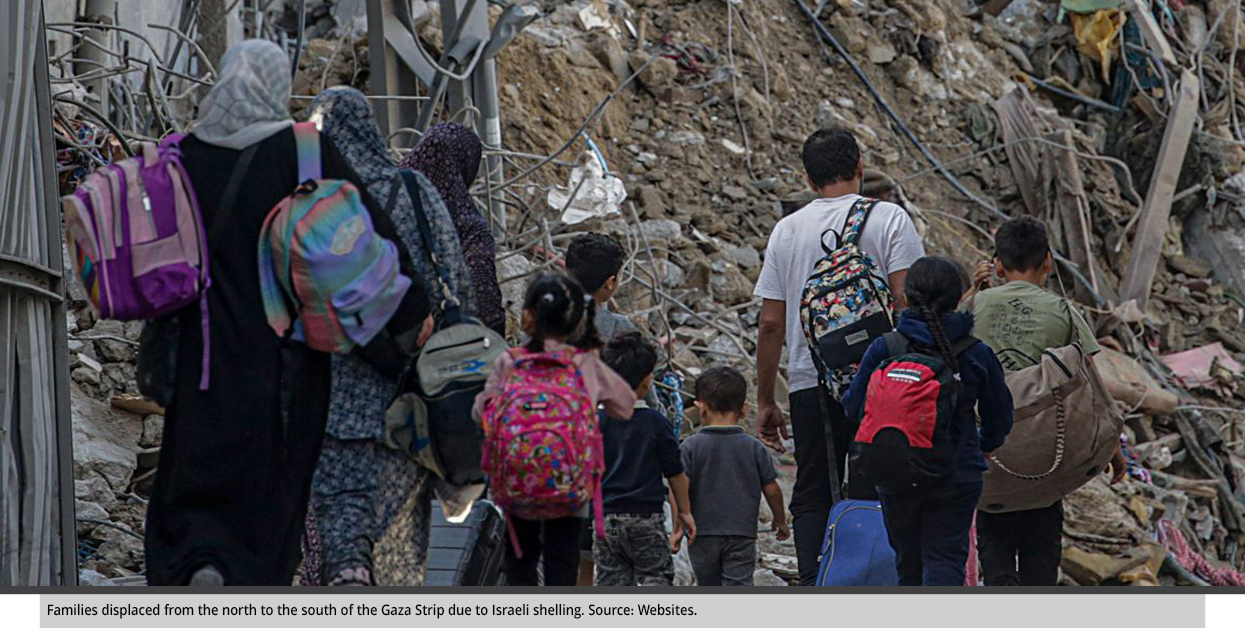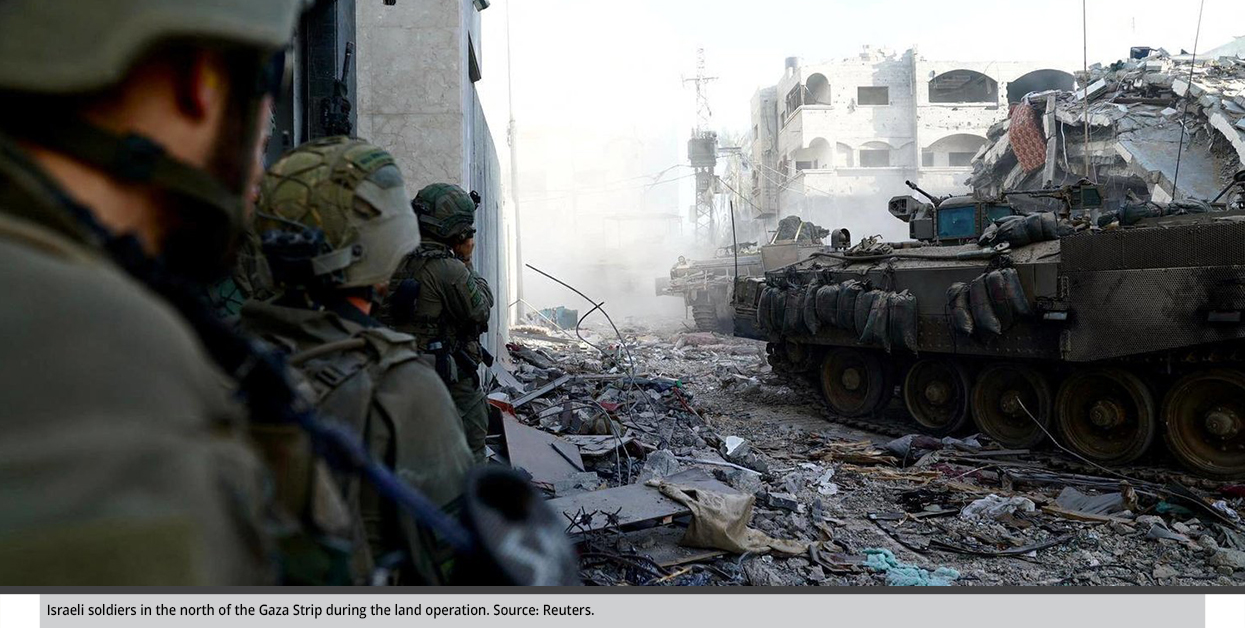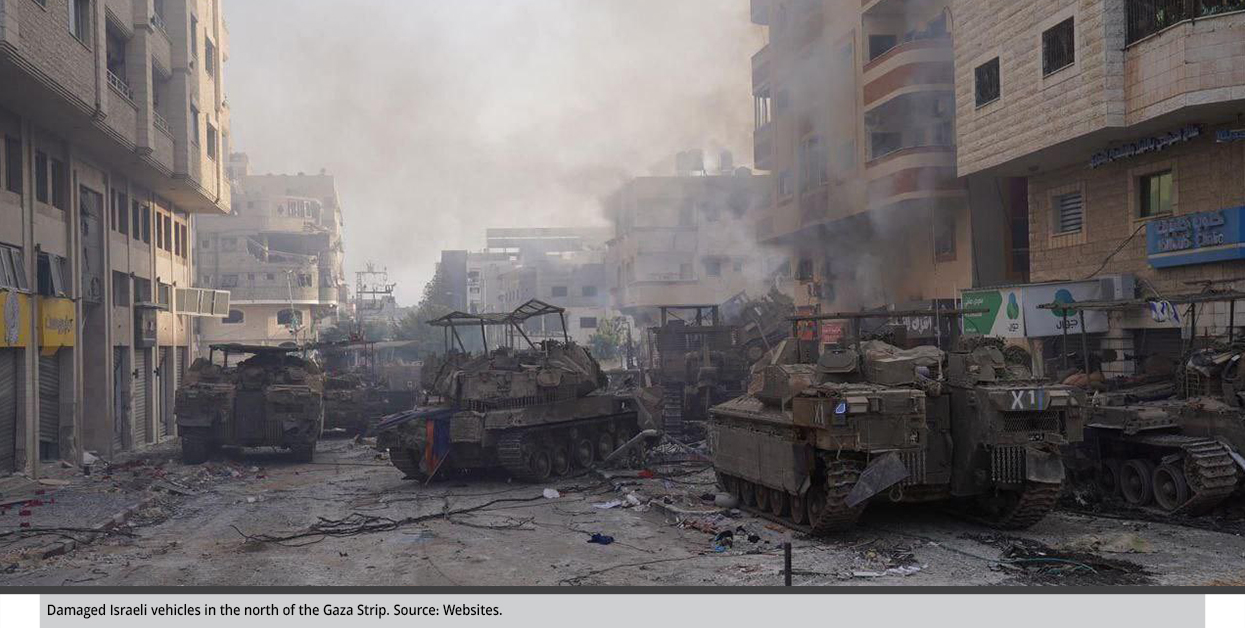Scenarios of the War on Gaza After the Truce
This position assessment addresses a set of likely scenarios for the course of the war on the Gaza Strip after the November truce. These scenarios are related to a set of indicators and data, some of which are associated with Israel and Gaza, while others are regional and international.
by STRATEGIECS Team
- Release Date – Nov 24, 2023

The humanitarian truce agreement between Israel and Hamas came into effect after a successful Qatari-Egyptian-U.S. mediation was announced November 22, 2023. The agreement included three basic items: a ceasefire for four at least four days, the daily entry of four trucks of fuel and 200 trucks of food and medicine, and the release of 50 hostages captured by Hamas in exchange for 150 Palestinians, women and children, detained in Israeli prisons.
The truce agreement was welcomed internationally as the first breakthrough in the war since it began October 7, resulting in the deaths of 14,000 Palestinians, 40% of whom were children, and wretched humanitarian conditions in the Gaza Strip. The truce could potentially change the course of the war, either by calming or escalating tensions.
This raises the question, what may ensue after the truce agreement?
First Scenario: Enhancing Ceasefire
The Israeli war on the Gaza Strip comes after multiple rounds of periodic fighting. The parties involved have become accustomed to ending conflicts through negotiation and agreeing on a ceasefire without delving into long-term peace arrangements. Israel, Hamas, and other Palestinian factions are experienced in developing ceasefires, however fragile, as seen in previous rounds of fighting and the 2014 war. The current truce agreement is likely to evolve into a ceasefire rather than just a humanitarian truce. There are six reasons why this truce could be the beginning of the search for political solutions.
1. The historical experiences, whether regarding Israeli wars or escalation rounds, indicate Israel’s adoption of the principle of rapid wars. This applies to previous Israeli wars in the Gaza Strip and its possible second war in Lebanon. In the case of the current war, several pressures—economic, military, and international—may push Israel to halt the war. News circulated about Israel’s intention to start dismissing reserve officers for economic reasons. Also, after nearly two months of combat, there is nothing to support Israel’s hope of eradicating Hamas or assassinating its leaders in the Gaza Strip.
2. Having agreed on the technical and procedural mechanisms for the recovery of prisoners, Hamas and Israel now have a system in place to release and exchange hostages and prisoners without the need to escalate military operations. This is what the United States was calling for since the beginning of the war. The White House and Congress gave the hostage-prisoner exchange deal priority over military operations given the risks to the lives of American and other hostages. The truce agreement addresses one of the most prominent causes of the war, especially as the Israeli Prime Minister Benjamin Netanyahu has tied any talk of a ceasefire to the release of all hostages.
3. The truce comes at a time when the Palestinian factions believe that their efforts to unify the arenas have not succeeded, and, thus, the extension and expansion of the two-month-old war became less likely than before. Also, the war’s continuation will lead to a further depletion of their weaponry and equipment stocks, as well as more deaths in the civilian population of the Gaza Strip.
4. It is likely that the indirect parties in the war—especially Hezbollah and the Palestinian factions in Lebanon, as well as armed groups in Iraq, Syria, and Yemen—will implicitly comply with the truce. This is vital in bringing calm to the region.
5. The war resulted in massive humanitarian hardships among the residents of the Gaza Strip. A four-day truce is woefully insufficient in providing enough time to supply all the residents with the necessary food and medicine they need to survive nor does it meet the requirements of sheltering the vast number of people displaced from the north. In this regard, international pressure on Israel has greatly increased.

6. The continuation of the war means the magnification of its risks to Israel. To bring an end to these risks, the option of a ceasefire is supported, as well as temporarily settling for a buffer zone inside Gaza, launching more organized and long-term campaigns, the continuation of low-intensity conflicts such as clashes and striking from behind the buffer zone, and keeping air operations minimal.
Second Scenario: The War Continues
The truce came at a time when Israel began to push its military operations forward in the northern areas of the Gaza Strip. Israel had determined its goal in the war from day one: eradicate and dismantle Hamas’s military capabilities. Israel pledged not to stop the war until it achieved that goal. There are circumstances that support the resumption of the war and the possibility of its deepening.
1. This is not the first time that Israel has stopped fighting. In early November, Israeli forces ceased fire for four hours to allow residents living in the north of the Gaza Strip to leave for the south. Israel intermittently allowed limited quantities of fuel, food, and medicine to enter the south of the Gaza Strip.
2. Israel needs the current truce not only to allow the release of hostages but also to facilitate its military operations in the northern side of the Gaza Strip, especially as Israel currently intends to penetrate the most crowded areas of Gaza, like the northern cities of Beit Lahia and Beit Hanoun. This requires reducing civilian casualties and international pressure.
3. The United States repeatedly announced its opposition to a ceasefire in the Gaza Strip, arguing that it benefits Hamas. Although the United States pushed for implementing humanitarian truces to facilitate the escape of citizens from combat sites and to allow humanitarian aid to enter, it also opposed a resolution by the United Nations General Assembly calling for a permanent humanitarian truce.
4. The wording of the agreement is clear and explicit in referring to a “truce” but not a “ceasefire.” This means that the agreement is short-term and non-permanent, as was the case in previous agreements between Hamas and Israel. For example, the 2014 war cessation agreement came under the title “Open Ceasefire,” which indicates a long stop to the fighting, even if that did not prevent the renewal of escalation rounds later, but it stops the course of the war and its ongoing events.
5. The field circumstances do not support a ceasefire, as Hamas and Israel are in direct engagement in the field. Israeli forces are still on the ground in the Gaza Strip, a matter that complicates any non-military arrangements that attempt to prevent clashes from taking place.
6. In reference to the previous point, the ceasefire procedures in the case of the current war require different and more complex arrangements than those outlined in the truce agreement. On the one hand, there is a need for neutral observers to resolve disputes and respond to any developments that arise between the warring forces, in addition to pledges provided by the warring parties and guaranteed by the mediating parties. It is unlikely that any ceasefire agreement will succeed as long as Israeli forces and Palestinian factions are present in the same field.

7. The prisoner exchange operation is not the only goal of the war. Military operations may continue in light of previous experiences of prisoner exchange operations, not all of which were successful for Israel. The release of the Israeli soldier Gilad Shalit came at the cost of releasing Yahya Sinwar, believed to be the mastermind behind the October 7 attacks.
8. The position of al-Jihad al-Islami Movement, which is more associated with Iranian policies, was not in conformity with Hamas regarding the conditions of the truce right from the beginning of negotiations about it. This was evident in the statements of Ziyad al-Nakhalah, the Secretary-General of the al-Jihad al-Islami Movement, on November 14: “The method of negotiation, related to our enemy’s prisoners, and its reactions may push the al-Jihad al-Islami Movement to be outside the deal. The Al-Jihad al-Islami Movement can keep its prisoners for better conditions.” This position cannot be separated from Iran’s interests, which favor the continuation of the war at this stage, especially after Iran was excluded from the mediation regarding prisoners and hostages.
Third Scenario: War Nature Changes
The agreement on a mechanism for a prisoner exchange, the increasing international pressure on Israel, and the enormous civilian casualties in the Gaza Strip may impose changes on the nature of the Israeli war, transforming it from a comprehensive war with complex goals into “surgical” military operations that are less intense and less impactful on civilians. This is especially true since Israel now has the ability to securely access most areas of the Gaza Strip. This scenario is supported by several circumstances.
1. The wording of the agreement encourages subsequent agreements or extending the current one to release as many prisoners as possible, exceeding the agreed-on number. The release of more prisoners would automatically extend the ceasefire periods for no more than 10 days.
2. While the release of 50 hostages will not alleviate the pressure on Netanyahu to secure the release of all remaining hostages held by the Palestinian factions, it may lead to increased pressure to release even more hostages through other truces that are perhaps being negotiated right now.
3. The difficulties of war and the complexities of its environment require periodic ceasefires so both sides can address secondary issues, be they military or humanitarian.

4. The war has completed its mission in establishing a prisoner exchange system, which means that its subsequent course can now focus more on strategic goals. At the same time, the current course of war maintains the military pressure that Israel believes is the means to free all hostages.
5. Hamas and Israel have communication channels through mediators and representatives, including the United States, Qatar, and Egypt. This means that under the right conditions, the chances of renewing or repeating the truce are more probable.
6. Israel achieving its war goals does not necessarily mean it will continue as it has or that it can’t also execute focused military operations and precise intelligence activities before reaching the stage of final security arrangements, such as targeting key leaders in Hamas and al-Jihad al-Islami, demolishing sensitive military facilities, and enhancing the current military presence that separates northern Gaza from its south.
Finally, the answer to the question about the course of the war post-truce will not be realized unless the truce holds throughout its four days, which may be a very difficult matter in this war, considering its complex environment.
In light of the Israeli military deployment inside the Gaza Strip, the continuation of intelligence monitoring operations, the risks of individual actions and complex fortifications, the overlap of some fronts between the Gaza Strip and Lebanon, the position of Hamas and Israel, and the guarantees of the mediators support the possibility of a successful, long-lasting truce, and from it will come further scenarios.

STRATEGIECS Team
Policy Analysis Team
 العربية
العربية